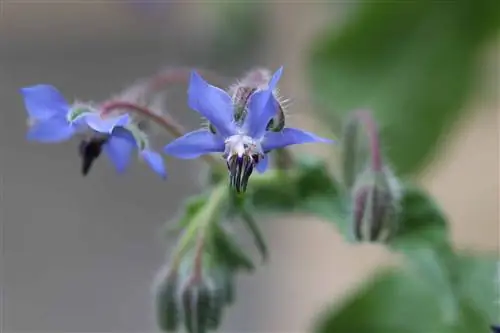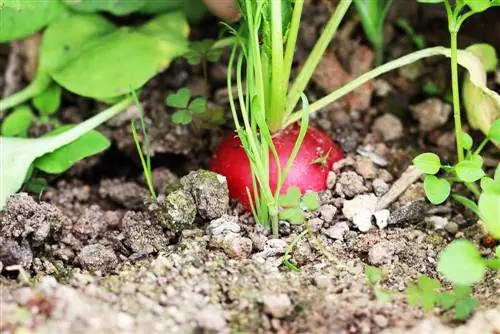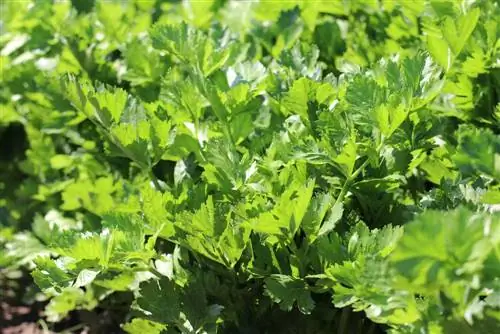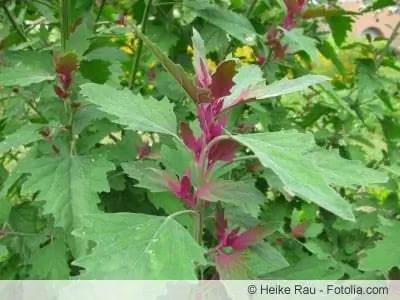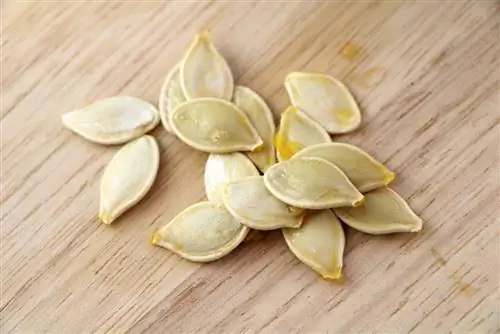- Author admin [email protected].
- Public 2023-12-17 03:39.
- Last modified 2025-01-24 12:45.
The bright blue flower stars of the borage plant are very decorative and immediately catch the eye. Not just us humans, but also the bees. Borage can be recognized immediately by these pretty flowers and the unmistakable cucumber scent of the leaves. It loves to grow on its own and is very easy to grow for use as a spice in the kitchen. It is also often cultivated between ornamental plants. Leaves and flowers can be dried for preservation.
Location and soil
Borage plants love a sunny, wind-protected location with loose, calcareous, moist soil with a pH value between 6.5 and 7.5. Sandy-loamy soils in partially shaded locations are also okay as long as they are not too firm. There should always be good drainage. Poorly permeable soils must be mixed with additives such as perlite or quartz sand. Soils that are too nutrient-rich or over-fertilized are not suitable for borage.
Sowing
In the cold frame
Borage can be sown in cold frames at the end of February or beginning of March. The seeds are sown in rows with a distance of approx. 15 centimeters. Since the seeds germinate in the dark, they should be covered with a thin layer of soil and pressed lightly. The first seedlings appear after about six to seven days.
In bowls
If you don't have a cold frame, you can also sow the Borago officinalis in small bowls or in a mini greenhouse on the windowsill. Distribute the borage seeds evenly over the potting soil and add a layer of soil on top. Press the soil lightly and spray it with water. Cover the seed trays with foil or glass panes. Mini greenhouses usually come with a lid. Place the vessels in a warm place and water and ventilate regularly.
Planting outdoors
Four weeks later, the young plants can be carefully removed and planted in their final location outdoors. Use a planting stick or a narrow, small shovel to plant and water the borage plants well.
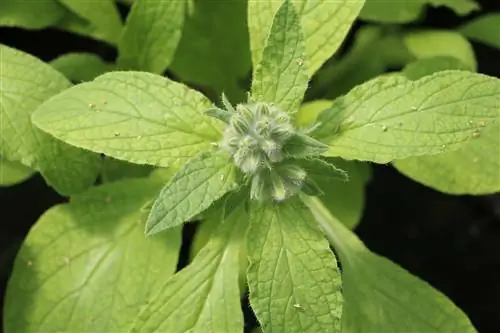
Tip:
Leave a distance of 30 centimeters between each plant so that they can develop well. If the soil is good and the location is good, some borage plants can grow up to a meter or more in height. However, they should then be tied up so that the wind cannot blow them over.
Outdoors
Borage or squill or squill, as it is popularly called, is only sown outdoors from April to mid-June. Here it is sown in rows at a distance of 30 centimeters, later isolated on site and further cultivated. However, the leaves of plants sown late can fall victim to the first night frosts in autumn.
pot culture
If you would like to plant borage in pots, troughs and buckets, you should make sure that its long taproot with pronounced runners is not restricted. It is therefore advisable to use so-called rose pots or other vessels with a cylindrical shape.
Tip:
Make sure that the water in the pot can always drain easily. It is best to place a drainage layer of gravel, coarse sand or perlite on a piece of clay over the drainage hole. Excess water in the coaster must always be poured out!
Watering and fertilizing
- Keep plant substrate moist regularly
- chop the soil well after watering
- mulch with grass clippings if necessary
- fertilization is not necessary
Plant neighbors
In the fruit and vegetable garden
Gooseberries and borage stimulate each other's growth and can therefore be easily planted together on the same bed. Borago officinalis is also very suitable as a plant neighbor for:
- cabbage
- Strawberries
- Zucchini
- Cucumbers
Natural flower areas
Borage is often planted in a bed with perennials, ornamental plants and various herbs, especially in natural gardens. It can also sow itself there:
- Sage
- Pimpinelle
- woman's coat
- Mallow
- Peppermint
- Coneflower
- fragrant phlox
- Lemon balm
- Camomile
Harvest
leaves
The fleshy, hairy borage leaves can be harvested from May. They retain their flavor all year round. That's why the borage can be harvested daily even while it's flowering. However, the young leaves are best.
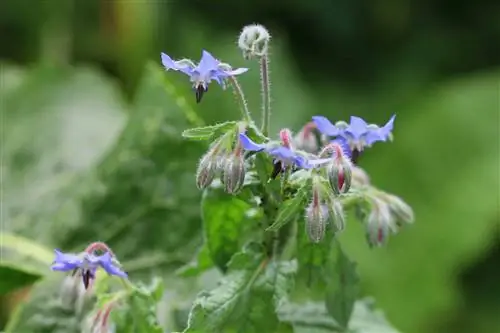
Flowers
From the end of May to the beginning of September, the borage plant produces star-shaped flowers that change their color from delicate pink to bright blue over the course of their flowering period. You can harvest the flowers throughout the flowering period.
Drying and storage
Flowers and leaves of the star of heaven, as borage is also often called, are gently dried in layers at approx. 40 °C. However, they are stored differently. The leaves are stored in cloth or paper bags. According to herbal experts, the flowers are stored in jars.
Tip:
If you like, you can hang the entire borage plant to dry and then remove the leaves and flowers. This is useful if the plants are to be removed from the bed anyway, for example after self-sowing.
Preserve in oil or vinegar
If you want to retain its intense taste, soak the borage in vinegar or oil. However, the flowers lose their color in vinegar.
Use in the kitchen
Young leaves are often used in sauces, salads and fish dishes. Borage is best known in the classic Frankfurt green sauce, which includes a total of six other herbs: cress, pimpinelle, chives, sorrel, chervil and parsley. In summer, the flowers are often frozen in ice cubes as decoration and added to iced tea or spritzer. Borage is also part of expectorant herbal tea mixtures in folk medicine. Borage seed oil is used as a dietary supplement and in cosmetics.
Tip:
Borage should be used sparingly, however, as it contains pyrrolizidine alkaloids.
Varieties
Borage doesn’t just bloom in blue. It is also available with white flowers. You can also grow perennial borage in your garden or house. Its botanical name is Borago laxiflora and is also often referred to as broken herb.

Like parsley, it comes from Corsica and Sardinia and has the same taste and usability as annual borage. However, it grows a little more delicate and doesn't get as tall. Its flowers are also smaller. The variety has a slightly overhanging habit and is therefore well suited for pots and balcony boxes. If you like to use the leaves, you prefer to grow this type of borage in the shade or partial shade. Because in the shade the leaves become tenderer and softer. This type of borage can tolerate frost down to -10 °C.
Conclusion
Borage is a decorative, herbaceous flowering plant that is used as a culinary and medicinal herb. It is mainly grown in gardens in Central Europe, while it is native to the Mediterranean region. It feels most comfortable on soils with good water supply in a sunny location. Otherwise, it is a rather undemanding plant that can beautify and green even problematic locations by self-sowing. The blue or white flowers are often visited by bees and bumblebees. The flowers and leaves can be used in the kitchen. Borage is also a valuable helper in the garden, as it is ideal for green manure. Because its long and well-branched taproots leave behind a fine, crumbly soil structure.

